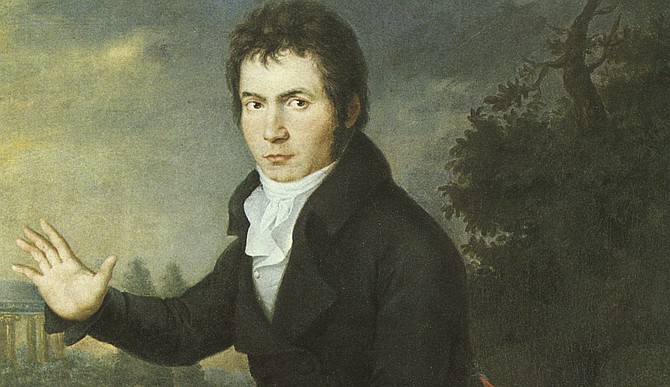 Facebook
Facebook
 X
X
 Instagram
Instagram
 TikTok
TikTok
 Youtube
Youtube

I entered Symphony Hall on Saturday, January 25, as the crustiest of all curmudgeons. I left as a young adventurer just returned from an invigorating sojourn through the Austrian countryside full of hope and optimism. In this concert, Edo de Waart and the San Diego Symphony played beyond expectations at all times.
John Polhamus and Garrett Harris discuss the San Diego Symphony's Jan. 25 performance.
The concert started with a performance of Beethoven’s Egmont Overture. The first thing I noticed as the orchestra was tuning is that there are four horns in the Egmont. Hmmm. Interesting. Let’s see how they play it.
The music started and soon I started to lean forward in my seat. The phrasing was magnificent. The articulation amongst those four horns was sharp. I leaned forward further as the strings finished each phrase leaning forward all the way to the end. I was stunned by the musical details in the playing.
At the end of the Egmont, I looked over to my concert companion with wide-eyed astonishment. He returned the same expression. There is nothing more that could have been asked for from a performance of the Egmont Overture. Nothing.
Ok, ok, I thought. Let’s see if this continues.
It did.
The second piece on the concert was Haydn’s Symphony No. 92: Oxford. The commitment from the players held through from start to finish with Haydn. The playing was stylish, polished, and clean.
I’m running out of superlatives for this concert and we haven’t gotten to Beethoven’s Symphony No. 6: Pastoral yet.
I applaud Edo de Waart for taking Beethoven’s Sixth Symphony out for a brisk walk. Maybe it was even a relaxed jog at times.
Were there a few stubbed toes during this invigorating excursion? Yes. However, when the orchestra plays with that much musicality, I care not about stubbed toes.
Musicality is kind of a catch-all term which signifies that the performers were giving us more than just the notes on the page. In addition to the musicality, the orchestra played with a sense of security.
Perhaps authority is a better word. The entire concert felt as though the orchestra was dominating the music. I can’t remember the last time I heard them play that way.
Interestingly, de Waart’s conducting looked the same. Yet every detail of phrasing was expressed by the players as opposed to the previous two concerts. I’m not sure what happened but a switch has obviously been flipped with this orchestra and the lights are all on.
https://www.youtube.com/watch?v=pzt8GgCNnhA


I entered Symphony Hall on Saturday, January 25, as the crustiest of all curmudgeons. I left as a young adventurer just returned from an invigorating sojourn through the Austrian countryside full of hope and optimism. In this concert, Edo de Waart and the San Diego Symphony played beyond expectations at all times.
John Polhamus and Garrett Harris discuss the San Diego Symphony's Jan. 25 performance.
The concert started with a performance of Beethoven’s Egmont Overture. The first thing I noticed as the orchestra was tuning is that there are four horns in the Egmont. Hmmm. Interesting. Let’s see how they play it.
The music started and soon I started to lean forward in my seat. The phrasing was magnificent. The articulation amongst those four horns was sharp. I leaned forward further as the strings finished each phrase leaning forward all the way to the end. I was stunned by the musical details in the playing.
At the end of the Egmont, I looked over to my concert companion with wide-eyed astonishment. He returned the same expression. There is nothing more that could have been asked for from a performance of the Egmont Overture. Nothing.
Ok, ok, I thought. Let’s see if this continues.
It did.
The second piece on the concert was Haydn’s Symphony No. 92: Oxford. The commitment from the players held through from start to finish with Haydn. The playing was stylish, polished, and clean.
I’m running out of superlatives for this concert and we haven’t gotten to Beethoven’s Symphony No. 6: Pastoral yet.
I applaud Edo de Waart for taking Beethoven’s Sixth Symphony out for a brisk walk. Maybe it was even a relaxed jog at times.
Were there a few stubbed toes during this invigorating excursion? Yes. However, when the orchestra plays with that much musicality, I care not about stubbed toes.
Musicality is kind of a catch-all term which signifies that the performers were giving us more than just the notes on the page. In addition to the musicality, the orchestra played with a sense of security.
Perhaps authority is a better word. The entire concert felt as though the orchestra was dominating the music. I can’t remember the last time I heard them play that way.
Interestingly, de Waart’s conducting looked the same. Yet every detail of phrasing was expressed by the players as opposed to the previous two concerts. I’m not sure what happened but a switch has obviously been flipped with this orchestra and the lights are all on.
https://www.youtube.com/watch?v=pzt8GgCNnhA
Comments